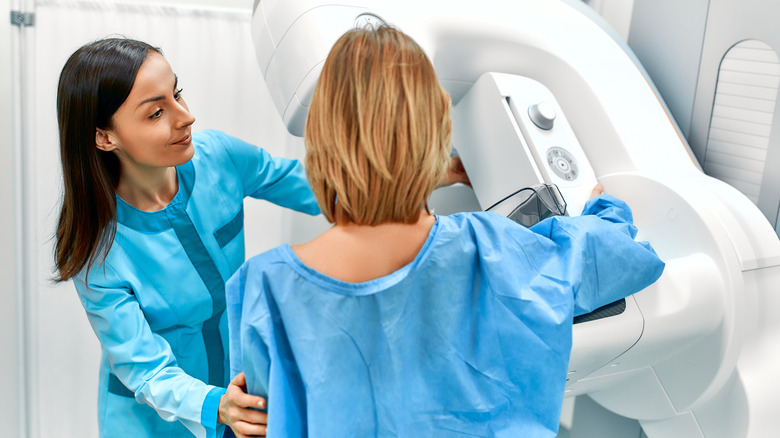What You Need To Know About Metastatic Breast Cancer, According To An Oncology Expert - Exclusive
The pink awareness ribbon has become synonymous with Breast Cancer Awareness Month and October. However, it's important to be informed about metastatic breast cancer year-round. Chances are, you know someone who has been affected by breast cancer — one in eight women will be diagnosed with it in their lifetime, and one in 833 men, too (via American Cancer Society). For women, it is the second-most prevalent form of cancer behind skin cancers.
The term metastatic may be confusing because it doesn't apply to all forms of breast cancer, but it is the most advanced form of the cancer (per Cleveland Clinic). Dr. Margaret Gatti-Mays, associate professor and breast medical oncologist at the Stefanie Spielman Comprehensive Breast Center at the James Cancer Hospital Solove Research Institute at The Ohio State University, explained the condition to Health Digest. "Metastatic means that the cancer has spread out of the breast and armpit and to other organs like the lung, bones, liver or brain," Dr. Gatti-Mays told Health Digest in an exclusive interview. "Once metastatic, the breast cancer is no longer curable, but with recent advances in cancer care it is treatable." Knowing signs and symptoms to look for can help patients seek treatment as quickly as possible.
Diagnosing metastatic breast cancer
The Centers for Disease Control and Prevention (CDC) recommends that women begin receiving mammograms every two years after they turn 50, or beginning earlier if an immediate family member has experienced breast cancer. Mammograms are a type of medical screening to check breast health. "While around 5% of all breast cancers are metastatic or stage IV at diagnosis, most breast cancers are diagnosed in the early setting by mammogram or a breast mass that can be felt [upon examination] and then become metastatic years later," says Dr. Gatti-Mays. Understanding the importance of early detection can allow breast cancers to be treated before they become metastatic.
If breast cancer does become metastatic, there are some signs that may indicate that cancer cells have spread to other parts of the body. "Women who develop metastatic breast cancer may experience symptoms like back pain, yellowing of the skin (jaundice), or headaches," Dr. Gatti-Mays says. "Patients with a history of breast cancer should always let their doctors know if they have any persistent or progressing symptoms that concern them." Once brought to your doctor's attention, additional tests may be ordered to determine if the cancerous cells have spread beyond the breast and armpit areas. These diagnostics might include lab work to check blood counts, tests to check the liver and kidneys, and imaging like CT scans or bone scans. If a test returns with abnormal results, a biopsy might be conducted for confirmation.
Risk factors and prevention
When it comes to risk factors for metastatic breast cancer, the answer isn't entirely clear. "Most patients do not have any identifiable risk factors and we don't know exactly why some women develop breast cancer," Dr. Gatti-Mays told Health Digest. "Some patients do have a genetic risk (like BRCA mutation), which increases their risk of breast and other types of cancers. In addition, some behaviors like tobacco use, alcohol use, medication use (like extra estrogen given for menopause), obesity, or prior radiation exposure may also increase a woman's risk of developing breast cancer."
Some ways to prevent or reduce your risk for metastatic breast cancer include limiting alcohol consumption to no more than one drink a day, maintaining a physically active lifestyle, and prioritizing weight management through exercise and a healthy diet (per Mayo Clinic).
When it comes to the BRCA-1 and BRCA-2 genes, every woman has the genes, but only an estimated one in 500 will have a mutation in either of the BRCA genes, according to the CDC. Approximately half of women with a BRCA gene mutation will end up being diagnosed with breast cancer by the age of 70, but there are preventative steps that can be taken alongside the guidance of a doctor. Some women with BRCA gene mutations opt to have a preventive mastectomy, the surgical removal of breast tissue, while others choose to closely monitor their breast health per their doctor's recommendations.
Can metastatic breast cancer be cured?
Compared to over a decade ago, technological and medical advances have significantly increased available treatments, but metastatic breast cancer does not have a cure. "Patients can now live with some types of metastatic breast cancer for many years after initial diagnosis, however, the overall five-year survival rate remains around 30% with great variations based on the breast cancer subtype," Dr. Gatti-Mays explains. "These survival rates are likely to improve in the coming years due to better treatments approved in the last five years."
"Most women I see in my breast oncology clinic never felt a breast mass," Dr. Gatti-Mays went on to say. "Early detection with routine mammograms is still the best way a woman can protect herself against breast cancer. We have a better chance of curing a small breast cancer that is limited to the breast than once the cancer cells have spread outside of the breast."
Since most people who experience metastatic breast cancer begin with an early stage breast cancer before the cells metastasize, early detection can be lifesaving. "I know it is scary for many women to confront the idea that they may have cancer, but early detection and diagnosis are very important," says Dr. Gatti-Mays.
To find out more about Dr. Gatti-Mays, find her at Dr. Margaret Gatti-Mays or learn more at The Ohio State Health & Discovery.




